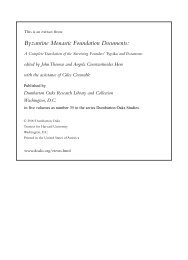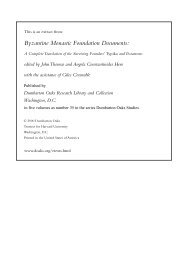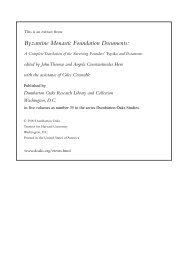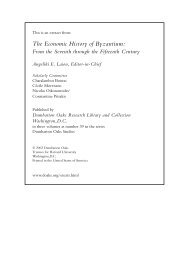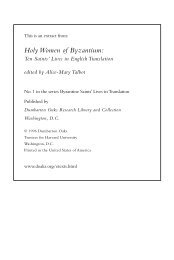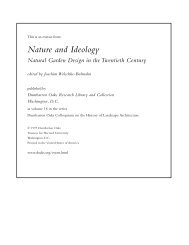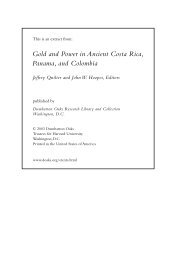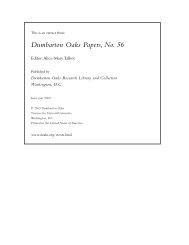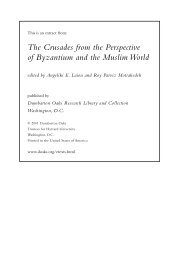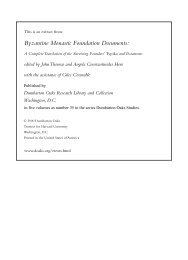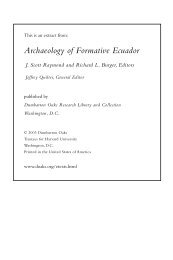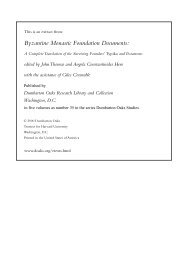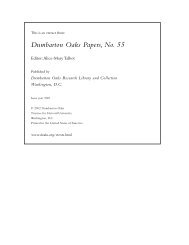3. Theodore Studites - Dumbarton Oaks
3. Theodore Studites - Dumbarton Oaks
3. Theodore Studites - Dumbarton Oaks
You also want an ePaper? Increase the reach of your titles
YUMPU automatically turns print PDFs into web optimized ePapers that Google loves.
<strong>3.</strong> THEODORE STUDITES<br />
Hesychios of Jerusalem: for whom see B. Baldwin, “Hesychios of Jerusalem,” ODB, p. 924. Some of<br />
the individuals cited here were important sources for the doctrine and institutions of the Studite monastic<br />
reform (see below, (4) Stoudios, The Studite Monastic Reform, C. The Sources of <strong>Theodore</strong>’s Reform<br />
Program). Their accuser, Pamphilos, is probably to be identified with the 6th century presbyter,<br />
Pamphilos of Jerusalem, author of a tract against the Monophysites. See Beck, KTL, p. 379<br />
<strong>3.</strong> Barsanouphios: Monophysite bishop of the sixth century condemned by Sophronios, for whom see Beck,<br />
KTL, p. 395; Isaiah, moderate Monophysite of the fifth century and author of ascetic tracts, for whom<br />
see L. Petit, “2. Isaïe,” in DTC, vol. 8, pt. 1, cols. 79–81; Dorotheos: a sixth-century Monophysite<br />
bishop; akephaloi, the “headless ones,” a name for the extreme Monophysites who refused to accept<br />
the Henotikon issued by Emperor Zeno (474–491) in 482.<br />
4. dekakeratos: derisive epithet of Monophysites. See Lampe, PGL, s.v.<br />
5. Patriarch of Jerusalem (634–638); the reference is to his letter to Patriarch Sergios (610–638) of<br />
Constantinople, ed. PG 87.3, cols. 3148A–3200C, that was read out during the Sixth Ecumenical Council<br />
at Constantinople in 681; see Henry, “<strong>Theodore</strong>,” p. 173, n. 1.<br />
6. Patriarch of Constantinople (784–806).<br />
7. Antony: Egyptian monk († 356), recognized as the founder of anchoritic monasticism; Ephraem: Ephraem<br />
Syrus († 373), Syriac monk, regarded as the founder of Syriac monasticism.<br />
8. John Klimakos, Scala paradisi, PG, 88, cols. 632A–672B: renunciation (apotage biou), freedom from<br />
desire (aprospatheia), and solitude (xeniteia).<br />
9. See below, [5].<br />
10. For the anatomical analogy, drawn from Pseudo-Basil, Constitutiones asceticae, PG 31, cols. 1381B,<br />
1396B, 1417BD, etc., see Leroy, “Réforme,” p. 199.<br />
11. The reference is to adelphopoiia (the adoption of a brother or sister for reasons of mutual support) and<br />
synteknia (baptismal sponsorship). On these spiritual relationships and the obligations and legal impediments<br />
they created, see R. S. Macrides, “Adelphopoiia,” ODB, 19–20; eadem, “Godparent,” ODB,<br />
p. 858.<br />
12. Naukratios, <strong>Theodore</strong>’s designated successor.<br />
Document Notes<br />
[1] Inalterability of the constitution (typos) and rule (kanon). Ep. 10, ed. Fatouros, vol. 1, p. 31, lines 4–6, is<br />
similar. Copied later by (13) Ath. Typikon [30].<br />
[2] Ban on personal possessions. Ep. 10, ed. Fatouros, vol. 1, p. 31, lines 6–7, is similar. Copied later by (13)<br />
Ath. Typikon [30].<br />
[3] Prohibition on use of monastic property for friends or relatives. Ep. 10, ed. Fatouros, vol. 1, pp. 31–32,<br />
lines 7–16, is similar. Copied later by (13) Ath. Typikon [30].<br />
[4] Ban on personal or agricultural slaves. Ep. 10, ed. Fatouros, vol. 1, p. 32, lines 16–21, is similar. This is<br />
probably a feature of <strong>Theodore</strong>’s reform program intended to return monasticism to the economic selfsufficiency<br />
more common in monasteries of late antiquity; possibly anticipated by his uncle Plato at the<br />
Sakkoudion monastery. See discussion by Leroy, “Réforme,” pp. 191–92, with Pargoire, “Loi<br />
monastique.” Copied later by (13) Ath. Typikon [31].<br />
[5] Ban on female domestic animals. Ep. 10, ed. Fatouros, vol. 1, p. 32, lines 21–24, is identical. See discussion<br />
by Pargoire, “Loi monastique,” and Leroy, “Réforme,” pp. 191–92. Leroy believes this is not<br />
moral legislation but an attempt to curtail cattle breeding and the attendant commercial activity to<br />
which that might give rise. This seems to have been the motivation for related legislation in (12) Tzimiskes<br />
[22], [23] and in (15) Constantine IX [3], but see (45) Neophytos [19] where the identical prohibition is<br />
motivated by fears of bestiality. Copied later by (13) Ath. Typikon [31].<br />
[6] Ban on the use of horses or mules. Ep. 10, ed. Fatouros, vol. 1, p. 32, lines 24–26, is similar. See<br />
subsequent related provisions in (12) Tzimiskes [22], (13) Ath. Typikon [31], and (15) Constantine IX<br />
[3]<br />
[ 81 ]




